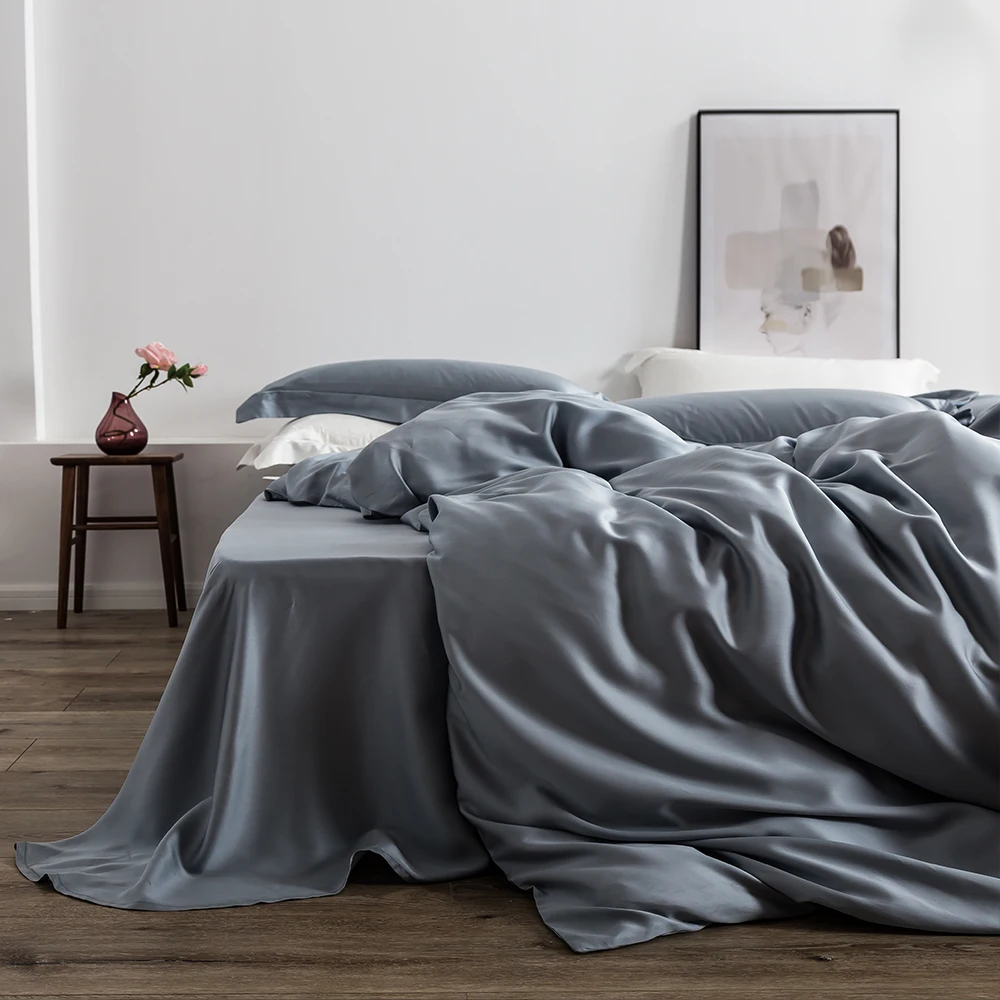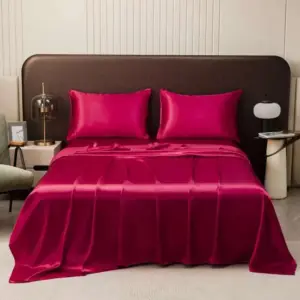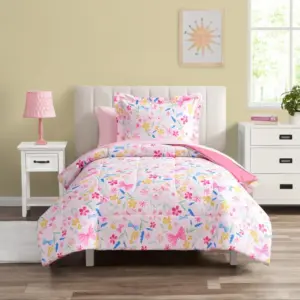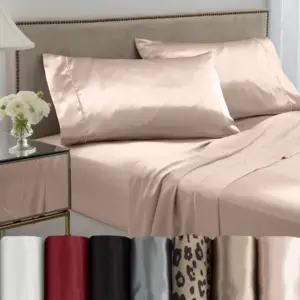The Allure of Layered Silk Bedding: Creating Your Perfect Sleep Sanctuary
Layered silk bedding arrangements represent the perfect marriage of function and style—transforming an ordinary bedroom into a haven of luxury. This thoughtful approach to bed styling combines multiple elements with silk as the star, creating a visual feast that invites you to sink into sumptuous comfort.
When we talk about layered bedding, we’re referring to the art of combining various bedding pieces—sheets, duvets, quilts, throws, and decorative pillows—in a way that creates both visual depth and practical comfort. While any fabric can be layered, silk elevates this concept to true luxury with its natural temperature regulation, incomparable drape, and gentle luminosity that catches the light in ways no other fabric can.
The amazing benefits of Mulberry silk sheets extend far beyond their beauty. For centuries, silk has been prized by royalty and the elite for its extraordinary properties. Today, this ancient luxury fabric remains the hallmark of high-end hotels and designer bedrooms, offering a sleep experience that synthetic alternatives simply cannot match.
In this comprehensive guide, we’ll explore how to create your own silk-centered sleep sanctuary, from understanding the fundamental layers that make up a perfectly dressed bed to mastering the art of fabric combinations, color strategies, and styling techniques that showcase Mulberry silk bed sheets at their finest. Whether you’re looking to completely transform your bedroom or simply elevate your existing setup with a few choice pieces, this guide to silk bedding combinations will help you create the layered silk bedding arrangement of your dreams.
Understanding the Essential Layers of a Luxurious Bed
Creating a truly luxurious bed requires understanding its fundamental structure—each layer serves both a practical purpose and contributes to the overall aesthetic. Think of your bed as a canvas where functional elements become part of the artistic display.
The perfect layered bed typically includes:
- Foundation layer: A quality mattress protector or pad that safeguards your mattress while adding a subtle layer of comfort
- Fitted sheet: The first layer to touch your skin, making silk fitted sheets an excellent choice for direct comfort
- Flat sheet: The initial decorative layer that also provides temperature control, where silk flat sheets shine with their smooth finish
- Main warmth layer: Your duvet or comforter, offering substantial insulation and visual impact as one of the most noticeable elements
- Mid-layers: Quilts and coverlets that add weight, texture and serve as transitional elements between the main layers
- Top layers: Decorative throws that contribute visual interest and provide additional warmth when needed
- Pillows: A combination of functional sleeping pillows and decorative accents that create dimension and complete the look
The beauty of layered bedding lies in its adaptability. During winter months, you might employ all layers for maximum warmth and visual richness. In summer, you might fold back the duvet and rely primarily on the breathable qualities of silk sheets with just a light throw for visual interest.
Beyond pure aesthetics, thoughtful layering provides practical benefits that enhance sleep quality. Multiple thin layers trap air between them, creating superior insulation compared to a single thick layer. This approach also offers flexibility—you can easily adjust your bedding throughout the night by adding or removing layers as needed.
The techniques employed in luxury hotels—with their precisely folded sheets, strategically placed pillows, and inviting turndowns—aren’t merely decorative. They’re designed to create an environment that appeals to all senses, particularly touch, which is why silk features so prominently in high-end bedding arrangements.
The Silk Advantage: Why Silk Transforms Layered Bedding
Silk possesses unique physical properties that make it the premier choice for creating luxurious layered bedding arrangements. Understanding these qualities helps explain why silk has maintained its status as the ultimate bedding fabric for centuries.
Natural Luminosity and Sheen
Unlike any other natural fiber, silk possesses an inherent luminosity that catches and reflects light in subtle ways. This creates a gentle glow that brings depth and dimension to bedding arrangements. When layered, silk’s sheen creates visual interest even within monochromatic color schemes, as each silk piece reflects light slightly differently depending on its position.
Exceptional Drape
The remarkable flow and drape of silk cannot be replicated by synthetic materials. This quality allows silk bedding to settle naturally into elegant folds and contours that follow the shape of your bed perfectly. The benefits of Mulberry silk sheets include this natural draping ability that creates an effortlessly luxurious look that’s difficult to achieve with stiffer fabrics.
Temperature Regulation
Silk’s most remarkable practical advantage is its natural thermoregulation. The unique structure of silk fibers makes them excellent insulators while simultaneously allowing for breathability. This means silk keeps you warm in winter and cool in summer—an ideal quality for bedding that will be used year-round. The thermal properties of silk bedding make it particularly valuable for creating comfortable sleep environments regardless of season.
Moisture Management
Silk naturally wicks moisture away from the body, absorbing up to 30% of its weight in moisture without feeling damp. This keeps you dry and comfortable throughout the night, preventing the clammy feeling that can occur with synthetic fabrics.
Hypoallergenic Properties
For those with sensitive skin or allergies, silk’s natural resistance to dust mites, mold, and certain allergens makes it an excellent choice for bedding. Its smooth surface also reduces friction against skin and hair, minimizing irritation.
Quality Indicators
When selecting silk for layered bedding, the momme weight (similar to thread count) is the key quality indicator. For bedding, the ideal range falls between 19-25 momme, balancing luxurious feel with practical durability. Lower weights may not provide sufficient opacity or longevity, while higher weights can be unnecessarily heavy without providing proportional benefits.
Many assume silk is too delicate for regular use, but quality silk bedding is surprisingly durable. With proper care, high-quality silk bedding can last for many years, making it not just a luxury but a sound investment in your sleep environment.
Artful Combinations: Pairing Silk with Complementary Fabrics
Creating truly stunning layered bedding arrangements often involves combining silk with other quality fabrics. These thoughtful pairings enhance silk’s natural properties while adding textural interest and visual depth to your bedroom design.
Silk + Cotton: This classic combination balances structure with flow. Cotton provides a stable foundation with its crisp texture, while silk adds luminosity and softness. For instance, pair crisp cotton percale fitted sheets with silk sheets as your top layer, or vice versa. The contrast between cotton’s matte finish and silk’s gentle sheen creates visual interest without competing textures.
Silk + Linen: For a contemporary yet timeless look, the pairing of smooth silk with natural linen creates beautiful textural contrast. Linen brings casual, lived-in texture while silk adds refinement. Try silk pillowcases against a linen duvet cover, or layer a silk throw over linen bedding for a look that’s both elegant and relaxed.
Silk + Velvet: When maximum luxury is the goal, combining silk with velvet creates unmatched richness. Both fabrics feature distinctive textures that complement rather than compete. A silk duvet cover paired with velvet euro shams creates a bed that invites both visual and tactile exploration, especially in jewel tones or deep neutrals.
Silk + Cashmere/Wool: For colder months, layering silk with fine wool or cashmere creates a perfect balance of temperature regulation and textural interest. Use silk sheets as your base layer, add a wool blanket for warmth, and top with a silk duvet cover for a bed that’s both cozy and refined.
Silk + Textured Weaves: Pairing smooth silk with more textured fabrics like matelassé, jacquard, or waffle weaves creates striking contrast. The smooth, flowing nature of silk becomes even more apparent when juxtaposed with these structured textures.
When combining fabrics, consider maintaining silk as either your foundation element (sheets, pillowcases) or as your statement piece (duvet cover, decorative throw). This creates visual coherence and prevents the arrangement from appearing too busy or disjointed.
The key to successful fabric pairing lies in balancing contrast with harmony. Choose fabrics that differ in texture but share either color family or visual weight to maintain a cohesive look. Remember that silk naturally draws the eye, so use this to your advantage by placing silk elements where you want to create visual focus.
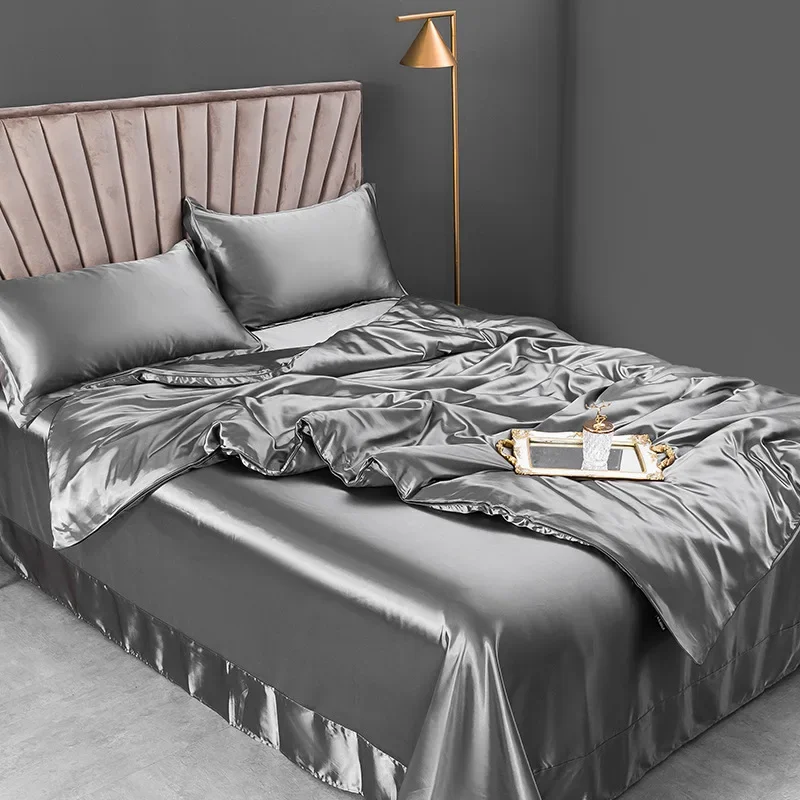
Creating Visual Harmony: Color Strategies for Silk Bedding Layers
Silk’s unique interaction with light means colors appear richer and more dimensional than in other fabrics. This natural luminosity affects how we perceive color in silk bedding, offering exciting possibilities for creating visual impact through thoughtful color strategies.
Monochromatic Layering
One of the most sophisticated approaches involves using varying shades of a single color. With silk, this is particularly effective because the fabric’s natural sheen creates subtle variations in how each piece reflects light. For instance, a bed dressed in various tones of blue silk—from pale sky to deep navy—creates depth and interest while maintaining an elegant, cohesive appearance. This approach works beautifully in both contemporary and traditional bedrooms.
Complementary Color Schemes
Pairing colors from opposite sides of the color wheel creates vibrant energy when executed thoughtfully. With silk’s natural luster, these combinations can be particularly striking. Consider combinations like:
* Dusty rose silk sheets with olive green accents
* Champagne silk bedding with occasional touches of navy
* Pearl gray silk duvet with subtle rust-colored decorative elements
The key is to use the bolder color sparingly as an accent to prevent overwhelming the space.
Color Blocking with Silk
Silk’s fluid drape makes it perfect for color blocking techniques. Use distinct sections of different colored silk pieces to create visual structure. For example, ivory silk sheets paired with a rich burgundy silk duvet cover and completed with charcoal silk decorative pillows creates a bold yet sophisticated statement.
Neutral Silk as a Canvas
Grey silk sheets and other neutral tones like ivory, taupe, and pearl serve as perfect foundations for more colorful accents. The subtle luster of neutral silk elevates it beyond ordinary bedding, while its versatility allows you to change accent colors seasonally or as your preferences evolve.
Lighting Considerations
Remember that silk’s appearance changes dramatically under different lighting conditions. Natural daylight brings out silk’s true colors and subtle variations, while warm artificial lighting enhances its golden undertones. Consider your bedroom’s primary light sources when selecting silk bedding colors to ensure the effect is pleasing throughout the day and evening.
When matching silk bedding to bedroom themes, consider the room’s overall color story. In smaller spaces, lighter-colored silk expands the visual space while adding luxurious texture. In larger bedrooms, deeper silk tones create intimacy and warmth without sacrificing sophistication.
The Art of Pillow Arrangement: Showcasing Silk Pillowcases and Shams
Pillows are perhaps the most versatile elements in layered bedding arrangements, offering endless opportunities to showcase the beauty of silk while adding height, dimension, and personality to your bed. Mastering the art of pillow arrangement elevates your entire bedroom aesthetic.
Fundamental Pillow Layering Structure
- Start with sleeping pillows: Position standard or king pillows (in silk pillowcases) horizontally against the headboard as your foundation
- Add structure with Euro shams: Place 26” x 26” European pillows in decorative shams against the headboard, standing upright
- Layer decorative pillows: Add medium-sized decorative pillows in complementary fabrics or patterns
- Finish with accent pillows: Small, distinctive pillows create visual interest at the forefront
Classic Hotel Style Arrangement
This timeless, symmetrical approach creates an orderly, refined appearance:
* Place 2-3 Euro shams (depending on bed size) upright against the headboard
* Position sleeping pillows in silk pillowcases horizontally in front of Euros
* Add two matching decorative pillows centered in front
* Finish with one small accent pillow or bolster centered at the front
Perfect for: Traditional bedrooms, master suites, and guest rooms where a polished, sophisticated look is desired.
Casual Luxury Arrangement
This relaxed yet abundant style conveys effortless elegance:
* Position Euro shams slightly offset rather than perfectly aligned
* Layer sleeping pillows at gentle angles rather than precisely horizontal
* Add 3-5 decorative pillows in varying sizes and complementary fabrics
* Arrange with deliberate asymmetry—more pillows on one side than the other
Perfect for: Bohemian or transitional bedrooms where comfort and individuality are prioritized.
Minimalist Elegance Arrangement
This restrained approach focuses on quality over quantity:
* Use just two oversized Euro shams in luxurious silk
* Place two sleeping pillows in coordinating silk pillowcases
* Add a single statement decorative pillow in a contrasting texture
* Maintain clean lines and ample negative space
Perfect for: Contemporary or modern bedrooms where simplicity and visual calm are desired.
For king beds, use three Euro shams and king-sized pillows; for queen beds, two Euro shams and queen pillows create proportional arrangements. Twin beds typically work best with one Euro sham and standard pillows.
When featuring silk pillowcases and shams, position them where their natural sheen will catch the light—typically at the front of the arrangement or slightly angled to catch ambient light from windows or lamps.
Mastering the Drape: Techniques for Styling Silk Duvets, Quilts, and Throws
The way bedding drapes across your mattress significantly impacts the overall aesthetic of your layered arrangement. Silk’s exceptional flow and natural weight make it ideal for creating elegant, inviting drapes that showcase the fabric’s inherent beauty.
Styling Heavier Silk Layers
The Full Spread: For maximum impact, spread the duvet or comforter fully across the bed, allowing it to fall evenly on all three sides (excluding the headboard side). This classic approach showcases the full expanse of silk’s luminous surface and works particularly well with patterned or richly colored silk duvets. To execute perfectly:
* Shake the duvet to distribute filling evenly
* Position it symmetrically on the mattress
* Allow approximately equal drop length on both sides and foot of the bed
* Smooth gently without flattening the natural loft
The Fold-Down: This inviting, hotel-inspired technique involves folding the top portion of the duvet down to reveal sheets beneath:
* Position the duvet so its top edge aligns with the top of the mattress
* Fold down the top third (approximately 12-18 inches)
* Create a clean horizontal fold line
* Tuck decorative pillows into the fold for added dimension
The Asymmetrical Drape: For casual elegance, position the duvet slightly off-center:
* Place the duvet with more overhang on one side
* Fold back one corner diagonally to reveal layers beneath
* Allow natural ripples and folds to form rather than smoothing completely
Styling Lightweight Silk Layers
The Corner Cascade: Perfect for silk throws and lightweight quilts:
* Fold the throw diagonally in half to create a triangle
* Position at one corner of the bed
* Allow it to cascade down the side in a waterfall effect
* Arrange to show the most attractive drape and flow
The Foot-of-Bed Fold: A classic approach for displaying silk throws:
* Fold the throw into thirds lengthwise
* Position across the lower third of the bed
* Allow excess to drape naturally over the foot of the bed
* Adjust to showcase any decorative edges or tassels
The Diagonal Drape: For dramatic visual interest:
* Fold the throw in half lengthwise
* Position it diagonally across the bed, from one corner to the opposite
* Allow ends to drape naturally over the sides
* Create gentle ripples rather than a perfectly flat appearance
Silk’s natural weight helps it stay in position better than lighter fabrics, but its smooth finish can sometimes cause slipping. To manage this, use gentle folds rather than tight tucks, and consider using decorative elements like pillows to anchor lighter silk pieces in place.
Seasonally, adjust your draping techniques to showcase more or less of your silk bedding. In warmer months, fold duvets further down to emphasize cool silk sheets, while in colder seasons, create cozier arrangements with multiple visible layers.
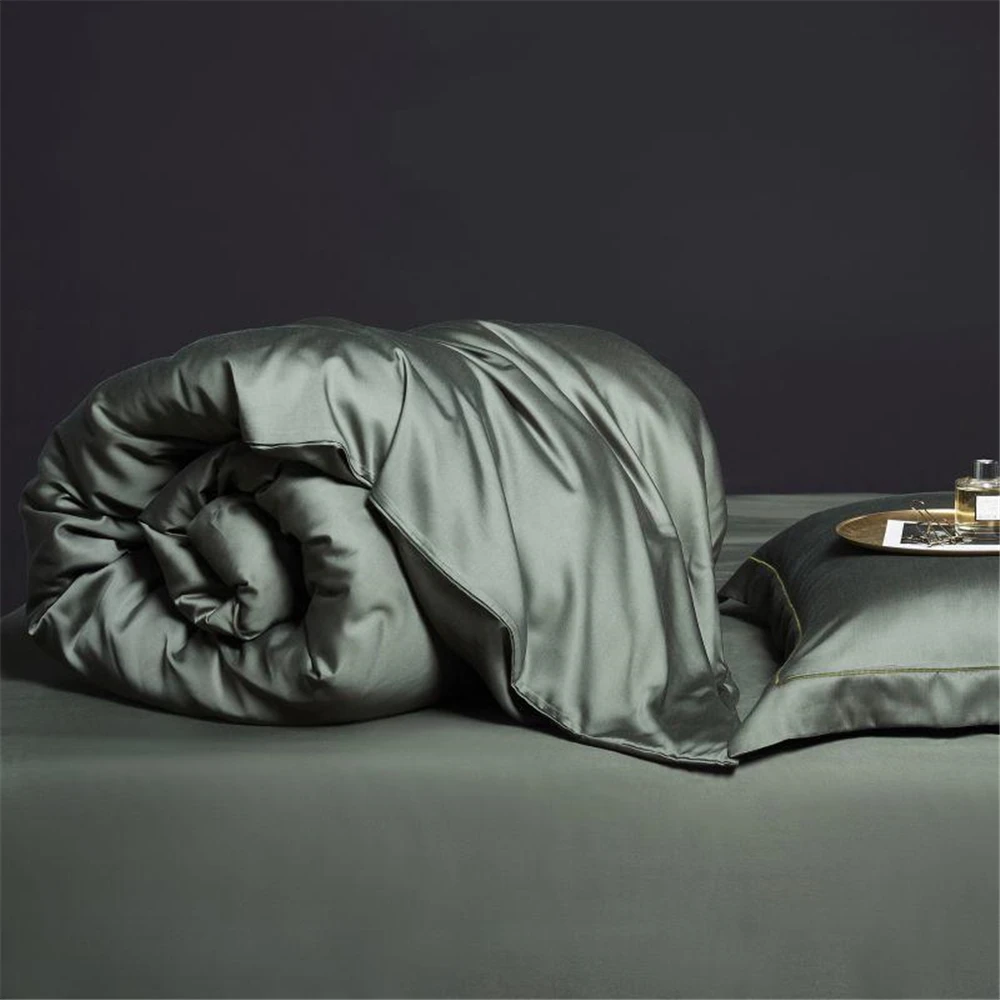
Seasonal Layering: Adapting Your Silk Bedding Throughout the Year
One of silk’s most remarkable qualities is its natural ability to regulate temperature—keeping you cool in summer and warm in winter. This makes silk bedding ideal for year-round use, though the way you layer and arrange it should adapt with the changing seasons.
Summer Layering Strategy
During warmer months, emphasize silk’s cooling properties with a lighter arrangement:
* Base layer: Fitted silk sheet directly against the mattress
* Top layer: Flat silk sheet as the primary covering
* Optional light silk blanket folded at the foot of the bed for chilly nights
* Minimal decorative elements to maintain airflow
* Fewer pillows to reduce heat retention
Cooling silk sheets in lighter colors like white, pale blue, or silver reflect heat and enhance the perception of coolness. Consider removing quilts and heavy duvets completely or storing them in a visible but purely decorative fold along the foot of the bed.
Fall Layering Strategy
As temperatures begin to drop, gradually introduce additional layers:
* Maintain silk sheets as your base for temperature regulation
* Add a lightweight silk-covered duvet or quilted coverlet
* Incorporate a decorative throw across the foot or corner of the bed
* Begin transitioning to richer, warmer colors like amber, copper, or burgundy
* Add 1-2 additional decorative pillows for visual warmth
Fall represents an ideal time to play with mixed textures—silk sheets paired with a velvet throw or cashmere accent pillows create inviting dimension while maintaining comfort during fluctuating temperatures.
Winter Layering Strategy
Create maximum warmth and coziness during cold months:
* Continue using silk sheets as your foundation layer for insulation
* Add a silk-covered down or high-quality synthetic duvet for substantial warmth
* Layer additional blankets or quilts between sheets and duvet
* Incorporate heavier throws in complementary fabrics like wool or cashmere
* Maximize pillow arrangements for both comfort and insulation
* Consider deeper, richer color palettes that enhance the sense of warmth
The best silk bedding for summer differs from winter arrangements primarily in weight and layering density rather than material. Silk’s year-round adaptability makes seasonal transitions seamless.
Spring Layering Strategy
As temperatures warm again, begin lightening your arrangement:
* Keep silk sheets as your constant foundation
* Begin removing heavier duvets or folding them down further
* Replace heavy throws with lighter alternatives
* Transition to brighter or softer color palettes
* Create a sense of airiness through lighter arrangement
When storing off-season silk items, avoid plastic containers which can trap moisture. Instead, use breathable cotton storage bags placed in cool, dry locations away from direct sunlight, which can damage silk fibers over time.
Styling for Different Bedroom Aesthetics
Layered silk bedding can enhance virtually any interior design style. By adjusting your approach to color, texture, and arrangement, silk can become the perfect complement to your existing bedroom aesthetic.
Modern Minimalist
This style emphasizes clean lines, uncluttered spaces, and a “less is more” philosophy:
* Color palette: Monochromatic schemes in whites, grays, blacks, or single bold colors
* Layering density: Minimal, with emphasis on quality over quantity
* Key elements: Crisp edges, geometric patterns if any, limited decorative pillows
* Silk application: Use silk’s natural sheen as a subtle textural element rather than a dominant feature
* Recommended arrangement: Low-profile, symmetrical pillow placements with precise folds and minimal draping
A modern minimalist approach might feature charcoal silk sheets with a slightly lighter gray duvet, one or two accent pillows in the same color family, and a single throw with clean lines placed precisely at the foot of the bed.
Classic Luxury
This timeless approach embraces richness, symmetry, and traditional elegance:
* Color palette: Rich jewel tones, metallics, ivory, and deep neutrals
* Layering density: Abundant, with multiple pillows and visible layers
* Key elements: Symmetrical arrangements, refined patterns, pleats and piping details
* Silk application: Showcase silk’s luminosity through multiple silk elements in complementary tones
* Recommended arrangement: Hotel-style pillow placement with decorative shams, carefully turned-down covers
Classic luxury styling might include ivory silk sheets, a champagne silk duvet with subtle damask pattern, multiple Euro shams, and decorative pillows in coordinating fabrics like velvet or silk with embellishments.
Contemporary Elegance
This balanced approach combines modern sensibilities with traditional comfort:
* Color palette: Soft neutrals with strategic accent colors
* Layering density: Moderate, with carefully chosen statement pieces
* Key elements: Mixed textures, subtle patterns, balanced asymmetry
* Silk application: Use silk for foundation pieces, complemented by other luxury fabrics
* Recommended arrangement: Relaxed but intentional draping, thoughtfully asymmetrical pillow arrangements
Contemporary elegance might feature taupe silk sheets, a pearl-colored duvet, and strategically placed accessories in accent colors like soft blue or terracotta, creating interest without overwhelming the space.
Bohemian Chic
This eclectic style embraces personal expression, mixed patterns, and artistic arrangements:
* Color palette: Rich, varied colors, often inspired by global influences
* Layering density: Abundant, with emphasis on mixed textures and patterns
* Key elements: Global textiles, vintage pieces, intentional “undone” appearance
* Silk application: Use silk as a luxurious counterpoint to more rustic elements
* Recommended arrangement: Relaxed, asymmetrical layering with deliberately casual draping
A bohemian approach might pair ruby silk sheets with a patterned quilt, multiple mixed throw pillows, and a silk throw casually draped across one corner of the bed.
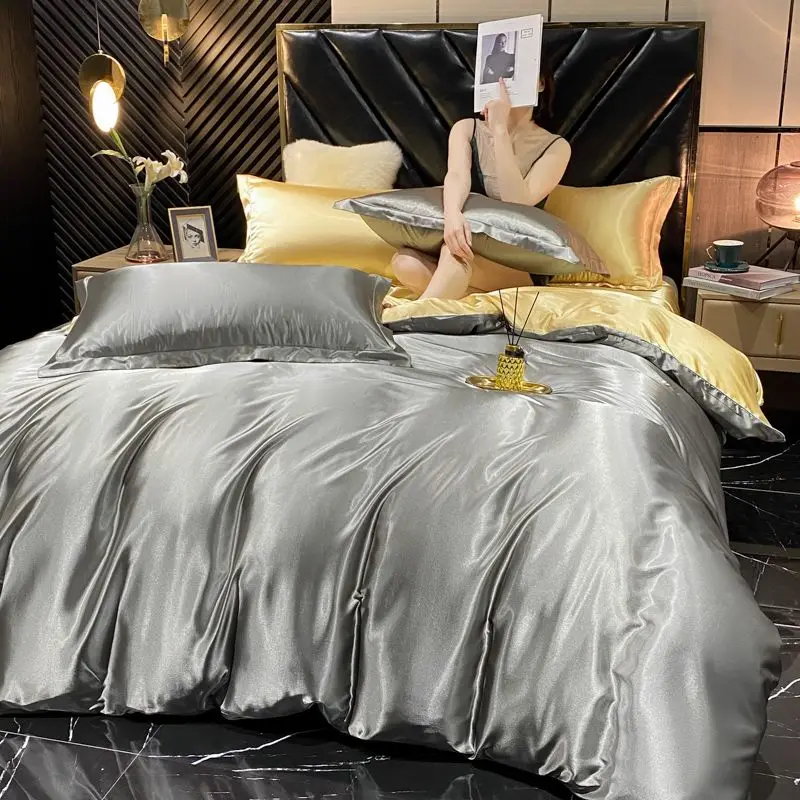
Essential Care Tips for Maintaining Layered Silk Bedding
Proper care ensures your silk bedding maintains its beauty and performance for years to come. While silk has a reputation for being delicate, quality silk bedding is surprisingly durable when handled correctly.
Washing Guidelines
- Water temperature: Always use cold or lukewarm water (30°C/86°F maximum)
- Detergent: Use mild, silk-specific or pH-neutral detergents free from enzymes, bleach, and brighteners
- Cycle: Select delicate/gentle cycle with low agitation
- Frequency: Wash sheets and pillowcases every 7-10 days; duvet covers and shams every 2-4 weeks
- Preparation: Turn items inside out and place in mesh laundry bags to prevent snags
- Separation: Wash silk items separately from other fabrics, especially those with zippers or hooks
Drying Techniques
- Air drying: Hang or lay flat away from direct sunlight
- Machine drying: Use air-only or lowest heat setting if necessary
- Timing: Remove promptly from washer to prevent wrinkles and creasing
- Handling: Avoid wringing or twisting wet silk which can damage fibers
Ironing Guidelines
- Temperature: Use silk/low temperature setting only
- Method: Iron while slightly damp for best results
- Protection: Place a clean cotton cloth between the iron and silk
- Alternative: Hang items in a steamy bathroom to release minor wrinkles naturally
Spot Cleaning
- Approach: Treat spills immediately with cold water
- Method: Blot gently without rubbing
- Products: Avoid spot removers unless specifically formulated for silk
- Drying: Pat with clean towel and allow to air dry naturally
Daily Maintenance
To maintain your layered silk arrangement between washes:
* Smooth sheets and duvet each morning to maintain appearance
* Fluff pillows daily to maintain loft and arrangement
* Rotate decorative elements periodically to distribute wear
* Keep direct sunlight off silk bedding when possible to prevent fading
For seasonal storage:
* Ensure items are completely clean and dry before storing
* Use breathable cotton bags rather than plastic
* Store in cool, dry locations away from direct sunlight
* Add cedar blocks rather than mothballs to protect against pests
California King Silk Fitted Sheet, King Size Silk Fitted Sheet, Mulberry Silk Fitted Sheet, Queen Size Silk Fitted Sheet
Price range: $120.04 through $390.79 Select options This product has multiple variants. The options may be chosen on the product pageFull-size Silk Sheets, King Size Silk Sheets, Queen Size Silk Sheets, Twin Size Silk Sheets, Washable Silk Sheets
Price range: $95.95 through $178.37 Select options This product has multiple variants. The options may be chosen on the product page100% Silk Sheets, Green Silk Sheets, King Size Silk Bedding Set, Mulberry Silk Bedding Sets, Queen Size Silk Bedding Set
Price range: $1,246.21 through $1,615.22 Select options This product has multiple variants. The options may be chosen on the product pagePink Silk Sheets, Twin Size Silk Sheets
$171.80 Select options This product has multiple variants. The options may be chosen on the product pageFull-size Silk Sheets, Pink Silk Sheets
$136.31 Select options This product has multiple variants. The options may be chosen on the product pageGrey Silk Sheets, Silk Sheet and Pillowcase Set
Price range: $88.20 through $146.64 Select options This product has multiple variants. The options may be chosen on the product page
What Makes Quality Silk Worth the Investment?
Understanding the markers of quality silk helps you make informed decisions when investing in bedding that will create the foundation of your layered arrangement.
Silk Varieties and Their Significance
Mulberry silk represents the highest quality silk available for bedding. Produced by silkworms fed exclusively on mulberry leaves, this silk yields longer, stronger, and more uniform fibers than other varieties. What makes mulberry silk special is its exceptional smoothness, durability, and consistent quality, making it the gold standard for luxury bedding.
Momme Weight
Momme (pronounced “mummy”) weight is to silk what thread count is to cotton. This measurement indicates the weight of 100 yards of silk that is 45 inches wide. For bedding:
* 16-19 momme: Lightweight, suitable for summer use, less durable
* 19-25 momme: Ideal range for bedding, balancing luxury feel with durability
* 25+ momme: Heavyweight, extremely durable but potentially less breathable
Most quality silk bedding falls within the 19-25 momme range, offering the optimal balance of luxury feel, proper drape, and longevity. Sanctuary Soft specializes in this premium range to ensure optimal performance.
Single vs. Double-Sided Silk
Quality silk bedding should feature silk on both sides of the fabric. Lower-quality products might use silk only on the visible side, with less expensive fabrics underneath. Always verify that your investment includes genuine silk on both sides for the full benefit of silk’s temperature-regulating properties.
Weave Types
Different silk weaves affect both appearance and feel:
* Charmeuse: The most common for bedding, with a smooth, lustrous face and matte back
* Habotai: Lightweight with moderate sheen, less durable for bedding
* Mulberry satin: Extremely smooth and lustrous, ideal for pillowcases and decorative elements
The weave affects not just appearance but how the fabric drapes, how it feels against skin, and its durability over time.
When shopping online, reputable retailers will clearly indicate:
* Silk type (specifically Mulberry silk)
* Momme weight (typically 19-25 for quality bedding)
* Construction details (seam finishing, closure types)
* Care instructions specific to their products
While silk bedding represents a higher initial investment than conventional bedding, its exceptional durability—often lasting 10+ years with proper care—makes it economical in the long run. Additionally, silk’s unique benefits for skin and hair health, temperature regulation, and comfort add value beyond mere aesthetics.
Many mulberry silk bedding sets combine multiple elements (sheets, pillowcases, duvet covers) at better value than purchasing pieces separately, making them an excellent foundation for your layered bedding collection.
Transforming Your Bedroom with Layered Silk: Getting Started
Creating a luxurious layered silk bedding arrangement doesn’t have to happen all at once. A thoughtful, phased approach allows you to build your collection over time while enjoying the benefits of silk from day one.
Essential First Investments
Start with these foundation pieces for maximum impact:
* Silk pillowcases: The most affordable entry point with immediate benefits for skin and hair
* Silk fitted and flat sheets: The foundation layers that directly touch your skin
* One statement piece: A silk throw or decorative pillow cover that adds instant luxury
This starter collection gives you the core elements needed to begin experiencing silk’s benefits while providing a foundation to build upon.
Building Your Collection Strategically
As you expand your collection:
1. Add a silk duvet cover next, as it’s highly visible and makes a significant impact
2. Incorporate decorative silk pillow shams to frame your sleeping pillows
3. Add a silk throw for versatile styling options
4. Consider seasonal pieces like a lighter silk blanket for summer
Focus on versatility in your early purchases. Neutral colors like ivory, pearl, champagne, or silver gray can be styled in countless ways and work with existing bedding you may already own.
Mixing with Existing Bedding
You don’t need an all-silk bed to create a luxurious look:
* Pair silk pillowcases with your current cotton sheets
* Layer a silk throw over your existing duvet
* Use silk decorative pillows against non-silk bedding for a touch of luxury
* Gradually replace cotton elements with silk as budget allows
The key is to position silk elements where they’ll have the most impact—either where they touch your skin directly (pillowcases, sheets) or where they’ll be most visible (decorative pillows, throws).
Personalization Tips
Remember that the most beautiful bedding arrangements reflect personal style:
* Choose colors that complement your existing decor and bring you joy
* Consider your sleeping preferences when selecting which pieces to prioritize
* Don’t be afraid to break “rules” if a different arrangement feels better to you
* Experiment with different layering techniques until you find what works best
Start with quality over quantity—one exceptional silk piece makes more impact than multiple lower-quality items. As your collection grows, you’ll develop an intuitive sense of how to layer and style your bedding for both visual appeal and personal comfort.
FAQ: Common Questions About Layered Silk Bedding
Is silk bedding worth the price?
Yes, when you consider both longevity and benefits. Quality silk bedding typically lasts 8-10 years with proper care, compared to 2-3 years for conventional bedding. Beyond durability, silk offers unique benefits including natural temperature regulation, reduced friction for hair and skin, hypoallergenic properties, and unmatched comfort. When calculated as cost-per-use over its lifetime, silk bedding often proves more economical than repeatedly replacing lower-quality alternatives.
How long does silk bedding typically last?
With proper care, high-quality silk bedding (19-25 momme) typically lasts 8-10 years before showing significant signs of wear. This longevity depends on following care instructions, avoiding harsh detergents, and protecting silk from direct sunlight when not in use. Many users report their silk pillowcases and sheets maintaining their luxurious feel even after years of regular use.
Can I machine wash silk bedding?
Yes, most modern silk bedding can be machine washed on gentle cycles with appropriate detergents. Always use cold or lukewarm water, select the delicate cycle, and place items in mesh laundry bags to prevent snags. However, always check the specific care instructions for your particular items, as some specialized silk pieces may require hand washing or professional cleaning.
Will silk bedding make me too hot/cold?
No—silk’s natural temperature regulation is one of its greatest advantages. Silk fibers contain protein structures that efficiently manage moisture and heat, keeping you cool when it’s warm and insulating when it’s cool. This makes silk ideal for year-round use and particularly beneficial for couples with different temperature preferences or individuals who experience night sweats or hot flashes.
How do I prevent silk sheets from slipping?
Silk’s smooth texture can sometimes cause slipping, especially on adjustable beds or with restless sleepers. To minimize this:
* Use high-quality fitted sheets with deep pockets and elastic all around
* Consider sheet straps or suspenders that attach under the mattress
* Place a thin cotton mattress pad between your mattress and silk fitted sheet
* Select silk with a slightly more textured weave rather than the slickest satin finish
What’s the difference between silk and satin bedding?
This is a common confusion. Silk is a natural fiber produced by silkworms, while satin is a weave pattern that can be made from various fibers (including silk, polyester, or nylon). Genuine silk bedding offers natural temperature regulation, moisture-wicking, and skin benefits that synthetic satin cannot provide. When shopping, look specifically for “100% silk” rather than simply “satin,” which might indicate a synthetic alternative without silk’s beneficial properties.

